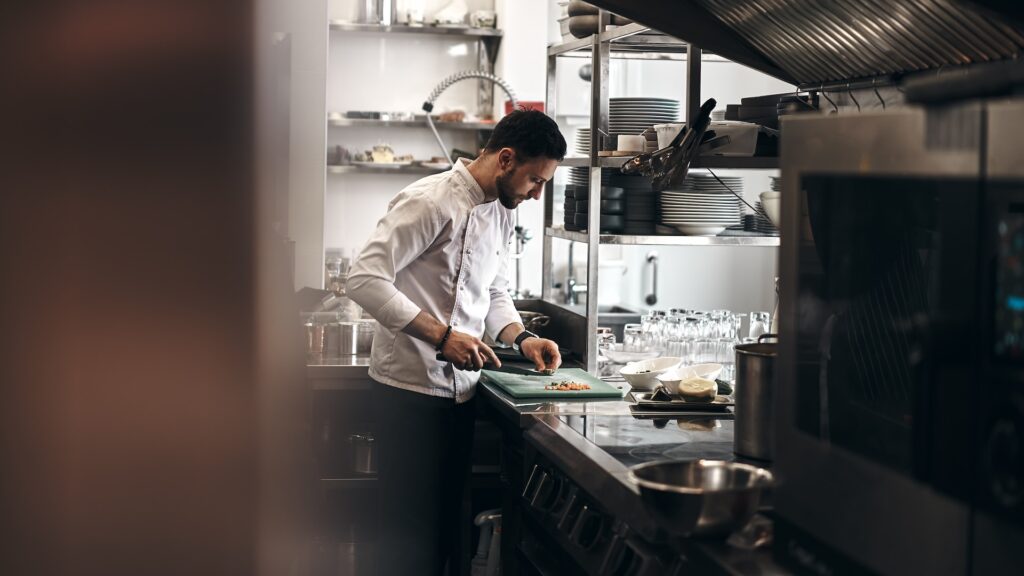Last Updated on October 24, 2023
Starting a restaurant business involves making numerous important decisions. Choosing the right commercial restaurant equipment is one of the most significant aspects to focus on. This isn’t just about opting for the most expensive or sophisticated pieces. It’s also about identifying items that suit your business model, contribute to an efficient workflow, and support your culinary vision.
Here are six items of kitchen equipment needed to open a restaurant:
1. Steam Ovens
In the restaurant industry, ovens play a crucial role. They’re fundamental tools for creating various dishes that can satisfy a wide variety of tastes.
There are different types of ovens on the market, each offering unique features and capabilities. Notably, combination steam ovens, also known as combi ovens, have become indispensable in the food business. They stand apart in their versatility and efficiency.
These units function in three modes—convection, steam, or a combination of the two. This means they can handle a range of tasks typically assigned to separate appliances, from baking and roasting to steaming and broiling. These ovens even possess the ability to smoke food.
Their unique combination mode provides accurate humidity control, improving the food’s texture and flavor while reducing the cooking time. They’re versatile, space-saving solutions becoming a must-have in restaurant kitchens.
The following are other types of steam ovens:
Conventional ovens: These can be either gas or electric and are suitable for most cooking needs. They’re easy to operate and are best for roasting or baking.
Convection ovens: Utilize a fan to circulate hot air, ensuring uniform cooking. Known for their efficiency, these ovens shorten cooking times and conserve energy.
Conveyor ovens: Typically used in pizzerias or other fast-paced environments, they convey food through a heated chamber for efficient and consistent cooking.
Choosing the right type of oven for your restaurant depends on your menu, kitchen space, and cooking needs. However, a combination steam oven may be the perfect fit for versatility and efficiency.
2. Cooking Equipment

Investing in reliable, high-performance cooking equipment is crucial. The most significant pieces comprise:
Stoves: Commercial-grade gas stoves are often the first choice for professionals due to their precise heat control, durability, and ease of cleaning. They allow chefs to quickly adjust temperatures, making them suitable for various dishes.
Grills: Be it charcoal, gas, or electric, grills impart a unique flavor to foods that customers love. Depending on your menu, a grill could be vital for preparing anything from juicy steaks to char-grilled vegetables.
Deep Fryers: These are essential, mainly if your menu includes items like crispy fries, chicken wings, or other deep-fried specialties. Opting for a top-notch fryer guarantees consistent results and effective operation.
The above pieces form the backbone of your kitchen, enabling you to serve delectable dishes to your customers.
3. Refrigeration Units
Refrigeration units, necessary for preserving ingredient freshness and ensuring food safety, are integral to any restaurant operation. Among these, reach-in refrigerators and freezers are the workhorses, storing everything from dairy products to meat and vegetables. They come in various sizes, allowing for adaptability based on your restaurant’s needs.
Under-counter refrigeration units are another worthwhile addition. They provide extra storage without taking up too much space and keep frequently used ingredients easily accessible for chefs, enhancing kitchen efficiency.
Lastly, display refrigerators serve a dual purpose. They keep food items at safe temperatures while also presenting them appealingly to customers, potentially driving sales.
Above all, choose durable, energy-conserving refrigerators capable of handling the demands of a busy restaurant. In doing so, you ensure optimal food quality and safety, contributing to an excellent dining experience for your customers.
4. Food Prep Equipment
Food preparation is a crucial stage in the cooking process, making the right equipment a necessity. A good place to start is with slicers. These machines, perfect for deli meats, cheeses, and even vegetables, offer consistent cuts, enhancing the presentation of dishes and aiding in maintaining portion control.
Next, consider food processors. These versatile gadgets can chop, grind, mix, or shred ingredients, accelerating prep time and ensuring consistency. They’re vital for preparing everything from salsa to dough.
Furthermore, blenders and mixers are indispensable. They’re central to numerous culinary tasks, including whipping up smoothies, blending soups and sauces, and kneading dough for bread or pastries.
Investing in top-quality kitchen tools enhances your kitchen’s efficiency, improves your dishes’ consistency, and can even inspire culinary creativity among your team. Remember, good food begins with excellent prep!
5. Essential Small Wares
Although often overlooked, small wares are vital to a restaurant’s daily operations. They include.
Cookware: Items such as pots, pans, and baking sheets are fundamental. They’re utilized in practically every dish prepared in a kitchen. It’s crucial to select durable cookware that can withstand high temperatures and constant use.
Cutlery, dishes, and glassware: These items not only serve a practical purpose but also enhance the dining experience. Selecting high-quality tableware can elevate your presentation and impress your customers.
Kitchen tools: They comprise knives, whisks, spatulas, and tongs. These tools assist in food preparation and cooking, making them invaluable.
Investing in superior small ware ensures durability and functionality. Remember, every detail in your restaurant contributes to the overall customer experience, down to the forks and knives they use.
6. Sanitation Equipment
Last but equally important is investing in sanitation equipment. Dishwashers, sinks, and cleaning tools ensure your restaurant stays clean and up to standard. Furthermore, they play a vital role in maintaining health and hygiene in your establishment, an utmost priority in the food service industry.
Conclusion
Starting a restaurant involves strategic decision-making, particularly when it comes to purchasing equipment. It’s about having the best cooking apparatus and investing in quality refrigeration units, food prep tools, small ware, and sanitation equipment. By getting this mix right, you set your restaurant up for success. You’ll be ready to provide high-quality food and service, making your establishment a favorite dining spot for many.
You may also like:
How to start a small restaurant
How To Increase Restaurant Sales
Main Advantages of commercial refrigeration for restaurants
 Travel for Food Hub The Food Blog for Travel Lovers
Travel for Food Hub The Food Blog for Travel Lovers
















